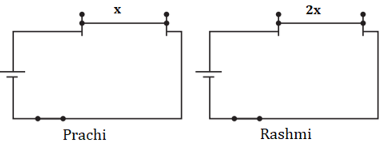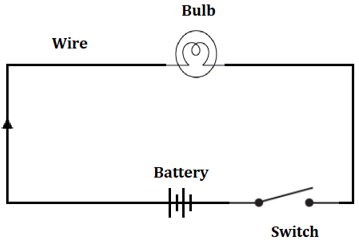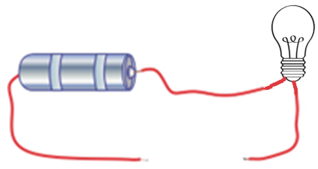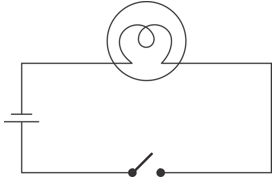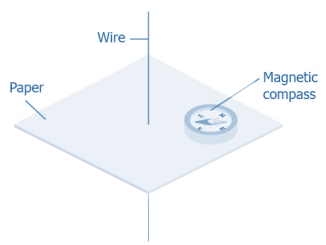Electric Current And Its Effects Worksheet
Objective Type Questions
- Match the following:
Column I Column II I Filament A safety device that melts and breaks an electric circuit during the time of overload or short circuit. II Fuse B The effect of an electric current that causes a conductor to become hot III Heating effect of electric current C The part of an electric bulb that gives off light when heated by an electric current IV Electromagnet D A magnet that is created by passing an electric current through a coil of wire wrapped around a core of magnetic material
State whether the statement is true or false: - An electromagnet can be used to remove plastic bags from a garbage pile.
State whether the statement is true or false: - The magnetic field of an electromagnet is always present in an electric bell, even when there is no electric current flowing through it.
- When an electric current flows through a wire, the wire gets heat up, this is known as _________.
- Unscramble the following words:
A.TCRICUI
B.RUTNREC
C.LUSINOTAR - Observe the following figures, write the names and complete the diagram.
Multiple Choice Questions - Which of the following devices uses electromagnets?
(a) Electric bells
(b) loudspeakers
(c) Junk separators
(d) All of the above - Shiwani constructed an electromagnet by wrapping 50 turns of wire around an iron screw. Ram also created an electromagnet by winding 100 turns around a similar iron screw. Which coil will draw the most paper clips?
(a) Shiwani's coil
(b) Ram's coil
(c) Both will attract the same number of paper clips
(d) Cannot be determine - The image represents an electric circuit with different components.
Which of the marked components represents a switch in the circuit?
(a) A
(b) B
(c) C
(d) D - Which of these precautions must be followed while working with electricity?
(a) Always touch a lighted electric bulb to see if it is hot
(b) Always pour water on a lighted electric bulb to cool it down
(c) Always switch off the main power supply before replacing a light bulb
(d) Always use a metal object to remove a broken light bulb from its socket - A homeowner wants to prevent damage to their electrical appliances due to a sudden power surge. Which of these devices should be installed to avoid damages?
(a) Miniature circuit breakers
(b) Light-emitting diode
(c) Compact fluorescent lamp
(d) All of the above - Arun performs an experiment where he connects two bulbs, an incandescent bulb and a CFL, to the same power source and recorded the electric consumption.
What will be the most likely conclusion from his experiment?
(a) Incandescent bulb will consume less electricity compared to CFL bulb.
(b) CFL will consume less electricity compared to an incandescent bulb.
(c) Both will use the same amount of electricity.
(d) CFL will consume more electricity also it will produce more light compared to an incandescent bulb.
Subjective Questions - Prachi and Rashmi both connect a wire of the same material and thickness to a circuit, but Rashmi’s wire is twice as long as Prachi’s wire.
If the power source across both circuits is same, will the heat produced in both cases be equal? Justify your answer. - Rajiv wants to reset an MCB that has tripped due to overloading or short-circuiting in his home. What steps should he follow to safely reset the MCB?
- The given image shows the arrangement of an electric circuit,
Case 1:
Case 2:
Draw an appropriate circuit diagram for both the cases. - As shown in the image, a student conducts an experiment in which he uses a copper coil to heat water. The water's initial temperature is measured to be 30°C. The student records the temperature of the water as 48°C after turning it on for 5 minutes. The water is allowed to cool back down to its original temperature.
The activity is then repeated with a copper coil half the length of the first copper coil. He notices that the water temperature has reached 37°C after 5 minutes. What conclusions can we draw from the activity?
Assertion-Reasoning Questions
Select the correct answer to these questions from the codes (a), (b), (c) and (d) as given below: - Assertion: Rajiv advised Simran not to use wet hands to operate electrical appliances such as a hair dryer or an electric kettle.
Reason: Water is a good conductor of electricity and can reduce the risk of electric shock. - Assertion- For an electric water heater wire of different materials, lengths, and thicknesses can be used to meet various requirements.
Reason- The amount of heat produced in a wire depends on its material, length and thickness. - Assertion- To reduce the household consumption of electricity, the government of India offers a substantial subsidy on the purchase of LED bulbs.
Reason- LED bulbs use less energy than incandescent bulbs, fluorescent tubes, or CFLs.
Case-Based Questions - Sima performed an experiment where she placed a magnetic compass near a current carrying wire. She notices some deflection in the compass needle.
(a) What does the deflection of the compass needle in Sima’s experiment indicate?
(b) What would happen to the deflection of the compass needle in her experiment if she moved the compass further away from the wire?
(c) What is the key observation she can draw from this experiment.
(d) Now if Sima suddenly switches off the power supply, what will she most likely observe?
Explore more Science Sample papers and Solutions
-
Nutrition in Plants Worksheet
- Nutrition in Animals Worksheets
- Heat Worksheet
- Acids, Bases And Salts Worksheet
- Physical And Chemical Changes Worksheet
- Respiration in Organisms Worksheet
- Transportation In Animals And Plants Worksheet
- Reproduction in Plants Worksheet
- Motion And Time Worksheet
- Light Worksheet
- Forests: Our Lifeline Worksheet
- Wastewater Story Worksheet
-
Competency Based Questions for CBSE Class 7 Science
-
Sample Papers for CBSE Class 7 Science Term 1 #1
- Sample Papers for CBSE Class 7 Science Term 1 #2
-
Sample Papers for CBSE Class 7 Science Term 2 #1
- Sample Papers for CBSE Class 7 Science Term 2 #2
Key Features of Study Materials of CBSE Class 7 Science:
- Easiest and most comprehensive study materials
- Designed by subject matter experts
- Revised according to the latest CBSE syllabus
- Helpful for quick revision
- ‘Ask a Doubt’ facility
- Significant improvement in marks



